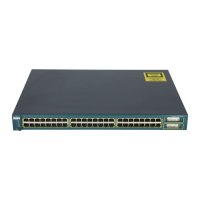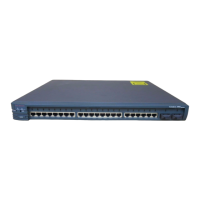204 Cisco LAN Switching Configuration Handbook
c. (Optional) Tune notification parameters.
■ Specify trap options:
(global) snmp-server trap-timeout seconds
(global) snmp-server queue-length length
SNMP traps are not sent reliably because no acknowledgment is required.
Traps can be queued and re-sent only when no route to the trap recipient is
present. In that case, the router waits seconds (default 30 seconds) before
retransmitting the trap. In addition, ten traps can be queued for each recipient
by default. You can use the queue-length command to set the queue size to
length traps each.
■ Specify the source address to use for notifications:
(global) snmp-server trap-source interface
SNMP traps can be sent from any available switch interface. To have the
switch send all traps using a single source IP address, specify the interface to
use. In this way, traps can be easily associated with the source switch.
d. (Optional) Enable SNMP link traps on specific interfaces:
(interface) [no] snmp trap link-status
By default, generate SNMP link traps on all interfaces when they go up or
down. If this is not desired, use the no keyword to disable traps on specific
interfaces. The default for IOS switches is to disable traps on all ports.
4. (Optional) Enable RMON support.
a. (Optional) Collect RMON statistics:
(interface) rmon collection stats index [owner name]
A switch collects RMON statistics only on the configured interfaces. Statistics
are gathered in “collections,” each uniquely identified by a collection number or
index (1 to 65535). An optional owner name (text string) can be given to associ-
ate a username with the collection.
b. (Optional) Collect RMON history statistics:
(interface) rmon collection history index [owner name] [buckets nbuckets]
[interval seconds]
A switch can collect history statistics on the configured interfaces. Statistics are
gathered in “collections,” each uniquely identified by a collection number or
index (1 to 65535). An optional owner name (text string) can be given to associ-
ate a username with the collection. The buckets keyword defines the number of
collection buckets to be used (default 50). The interval keyword specifies the
number of seconds (default 1800 seconds) during the polling cycle.

